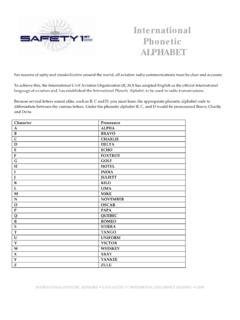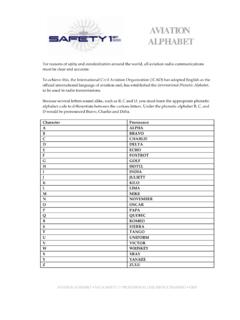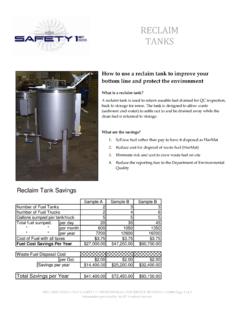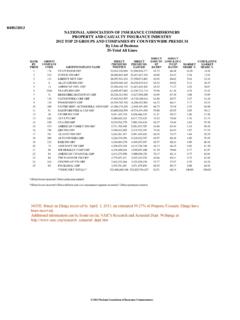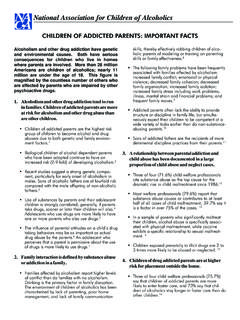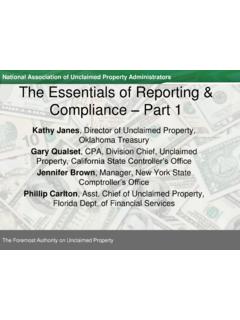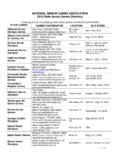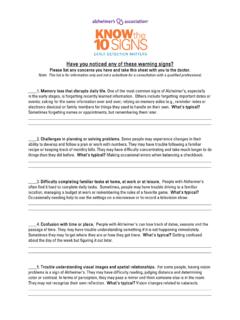Transcription of NFPA - National Fire Protection Association
1 NFPA - National fire Protection Association Definition The National fire Protection Association , NFPA, a private non-profit organization, is the leading authoritative source of technical background, data, and consumer advice on fire Protection , problems and prevention. Their web site is The primary goal of NFPA is to reduce the worldwide burden of fire and other hazards on the quality of life by providing and advocating scientifically-based consensus codes and standards, research, training, and education. Further Information NFPA has over 300 codes worldwide which are for sale through their web site.
2 These codes cover every conceivable topic including basic fire safety, the National Electrical Code, and life safety. These codes are developed and updated through an open process, ensuring their broad acceptance. MSDS Relevance While NFPA codes cover several aspects of flammable materials pertinent to H MSDS's, perhaps the most significant is the NFPA 704 Hazard Identification ratings system (the familiar NFPA "hazard diamond". shown on the right) for health, flammability, and instability. The NFPA's fire Protection Guide to azardous Materials, 13th edition includes NFPA 704, "Standard System for the Identification of the Hazards of Materials for Emergency Response" as well as pertinent information from a variety of other NFPA publications (including NFPA 704 ratings for over 3,000 specific chemicals, information not included with NFPA 704).
3 What do the numbers and symbols on an NFPA fire diamond mean? The diamond is broken into four sections. Numbers in the three colored sections range from 0 (least severe hazard) to 4 (most severe hazard). The fourth (white) section is left blank and is used only to denote special fire fighting measures/hazards. At first glance, the HMIS and NFPA labeling systems appear quite similar. Both have four sections colored blue, red, yellow and white. HMIS uses colored bars, while NFPA uses colored diamonds. HMIS . attempts to convey full health warning information to all employees while NFPA is meant primarily for fire fighters and other emergency responders.
4 Some employers use hybrids of the two systems. For example, they will use an NFPA hazard diamond, but the white section is used to denote both personal protective equipment (PPE) and/or special hazards. Both the NFPA and NPCA discourage mixing of the two systems in this manner. OSHA permits one to use any labeling system as long as it meets their labeling performance requirements. Thus, if you use a hybrid system at your location, your employees must be properly trained in using it and be made aware of these potential conflicts. Health Hazard Very short exposure could cause death or 4 serious residual injury even though prompt medical attention was given.
5 Short exposure could cause serious 3 temporary or residual injury even though prompt medical attention was given. Intense or continued exposure could cause temporary incapacitation or possible residual 2 injury unless prompt medical attention is given. Exposure could cause irritation but only minor 1 residual injury even if no treatment is given. Exposure under fire conditions would offer no 0 hazard beyond that of ordinary combustible materials. Flammability Will rapidly or completely vaporize at normal 4 pressure and temperature, or is readily dispersed in air and will burn readily.
6 Liquids and solids that can be ignited under 3 almost all ambient conditions. Must be moderately heated or exposed to 2 relatively high temperature before ignition can occur. 0 Materials that will not burn. Instability1. Readily capable of detonation or of explosive 4 decomposition or reaction at normal temperatures and pressures. Capable of detonation or explosive reaction, but requires a strong initiating source or must 3 be heated under confinement before initiation, or reacts explosively with water. Normally unstable and readily undergo violent decomposition but do not detonate.
7 Also: may 2 react violently with water or may form potentially explosive mixtures with water. Normally stable, but can become unstable at elevated temperatures and pressures or may 1 react with water with some release of energy, but not violently. Normally stable, even under fire exposure 0 conditions, and are not reactive with water. 1. Prior to 1996, this section was titled "Reactivity". The name was changed because many people did not understand the distinction between a "reactive hazard" and the "chemical reactivity" of the material. The numeric ratings and their meanings remain unchanged.
8 Special Hazards This section is used to denote special hazards. There are only three NFPA 704 approved symbols: This denotes an oxidizer, a chemical OX which can greatly increase the rate of combustion/ fire . This denotes gases which are simple asphyxiants. The only gases for which this SA symbol is permitted are nitrogen, helium, neon, argon, krypton, and The use of this hazard symbol is optional. Unusual reactivity with water. This indicates a potential hazard using water to fight a fire involving this material. When a compound is both water-reactive and an oxidizer, the W/bar symbol should go in this quadrant and the OX warning is placed immediately below the NFPA.
9 Diamond. Some organizations use other symbols, abbreviations, and words in the white Special Hazards section. NFPA 704 permits the use of additional symbols, but they must be placed outside of the NFPA diamond. The following symbols are not compliant with NFPA 704, but we present them here in case you see them on an MSDS or container label. This indicates that the material is an acid, a ACID corrosive material that has a pH lower than This denotes an alkaline material, also called a ALK base. These caustic materials have a pH greater than This denotes a material that is corrosive (it could be COR either an acid or a base).
10 This is a another symbol used for corrosive. The skull and crossbones is used to denote a poison or highly toxic material. See also: CHIP. Danger symbols. The international symbol for radioactivity is used to denote radioactive hazards; radioactive materials are extremely hazardous when inhaled. Indicates an explosive material. This symbol is somewhat redundant because explosives are easily recognized by their Instability Rating. The exact guidelines by which you can place a chemical in one of these four categories are available in the NFPA standard (see Further Reading below).
